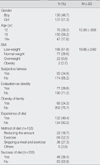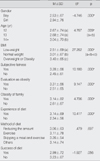Abstract
Purpose
The purpose of this study was to examine the relationship between eating disorders and parent-adolescent communication in middle school students.
Methods
There were 267 adolescents taken as participants from two middle schools in rural areas. Data were collected from June to July 2005, using the Eating Disorder Inventory-2 questionnaire (23 items) and Parent-Adolescent Communication Inventory (10 items for open family communication, 10 items for problem in family communication). The SPSS Win version 12.0 was used for descriptive analysis, t-test, and partial correlation coefficient.
Results
The mean score on the eating disorder was 2.74 (range: 1-6). Meanwhile, the mean scores on the parentadolescent communication was 3.37 (range: 1-5). There were significant differences in eating disorders according to gender, age, negative perception of the participant's body weight, family's perception of obesity, diet experiences, and BMI. Eating disorders showed a significant negative correlation with parent-adolescent communication.
Figures and Tables
References
1. American Psychiatric Association. Diagnostic and statistical manual of mental disorders. 1994. 4th ed. Washington, DC: Author.
2. Arcelus J, Button E. Characteristics of university students referred to an eating disorders service. Eur Eat Disorders Rev. 2007. 15:146–151.
3. Baek KS, Kwon YS. The effect of parent-adolescent communication types on the adaptation of adolescent school life. J Adolesc Welf. 2004. 6(2):87–99.
4. Barnes HL, Olson DH. Olson DH, editor. Parent-adolescent communication Scale. Family inventories: Inventories used in a national survey of families across the family life cycle. 1982. St paul: Family Social Science, University of Minnesota.
5. Bas M, Kiziltan G. Relations among weight control behaviors and eating attitudes, social physique anxiety, and fruit and vegetable consumption in Turkish adolescents. Adolescence. 2007. 42:167–178.
6. Choi EJ. The meta-analysis about the related variables of eating disorder. 2005. Daegu: Kyungpook National University;Unpublished master's thesis.
7. Drug diet, it is dangerous to adolescents. Weekly chosun, 1970. 2007. 09. 03. retrieved from http://weekly.chosun.com.
8. Galvin KM, Brommel BJ. Family communication: Cohesion and change. 1986. 2nd ed. Glenview, Ill: Scott, Foresman.
9. Garner DM, Olmsted MP, Polivy J. Development and validation of a multidimensional eating disorder inventory for anorexia nervosa and bulimia. J Eat Disord. 1983. 2:15–33.

10. Hong YL. Stressor, coping style, communication with mother & school adaptation in 6th grade elementary school children. J Korean Acad Child Health Nurs. 2000. 6:362–371.
11. Hur CS, Yang MC. The relationships between parentchild communication types and their ego-state. J Stud Guid. 2006. 27(1):15–36.
12. Kim YH. The interrelationship between the juvenile delinquency and the couple relationship, parent-adolescent communication, and family functioning. 1990. Seoul: Sook Myung Women's University;Unpublished doctoral dissertation.
13. Kim SH. Research of juveniles's problematic behavior- Focusing on the communication pattern between parents and children and on the problematic behaviors of peer group-. 2003. Gyeongsan: Yeungnam University;Unpublished master's thesis.
14. Kim JY. A study on the factors related to perception on body image, weight control attitude, and dietary behaviors in Korean adolescents by body image satisfaction. 2006. Seoul: Chung-Ang University;Unpublished master's thesis.
15. Kim YS, Kong SS. A study on weight-control behaviors, eating disorder symptoms and depression among female adolescents. J Korean Acad Psych Mental Health Nurs. 2004. 13:304–314.
16. Kong IS, Lee EJ, Lee JL. Adolescents' conflict, communication with parents and their self-concept. J Korean Living Sci. 2005. 14:925–936.
17. Lee IS. Eating and dieting style of college women. Korean J Clin Psychol. 1997. 16(1):87–100.
18. Lee JY. Eating disorder of women in their twenties case study. 2007. Seoul: Ewha Womans University;Unpublished master's thesis.
19. Lee KH, Kim SK, Chun KJ, Han SH. The relationship between eating disorder and self-esteem in female college students. Korean J Women Health Nurs. 2003. 9:390–399.

20. Machado PP, Machado BC, Goncalves S, Hoek HW. The prevalence of eating disorders not otherwise specified. Int J Eat Disord. 2007. 40:212–217.

21. Ogden J, Steward J. The role of the mother-daughter relationship in explaining weight concern. Int J Eat Disord. 2000. 28(1):78–83.

22. Park SH. A study on the communication of internet addicted youth. 2002. Jeonju: Jeonju University;Unpublished master's thesis.
23. Pesa JA, Turner LW. Fruit and vegetable intake and weight-control behaviors among US youth. Am J Health Behav. 2001. 25(1):3–9.

24. Senra C, Sanchez-Cao E, Seoane G, Leung FYK. Evolution of self-concept deficits in patients with eating disorders: The role of family concern about weight and appearance. Eur Eat Disorders Rev. 2006. 15:131–138.

25. Soh NL, Touyz SW, Surgenor L. Eating and body image disturbances across cultures: A review. Eur Eat Disorders Rev. 2006. 14:54–65.

26. Song MR, Ahn HY, Kim EK. A study on the correlation between stress, mother-adolescent communication and quality of life in the adolescence. J Korean Acad Child Health Nurs. 2002. 8:141–151.
27. Sohng KY, Park CS. Eating habits, trend of disordered eating, weight reduction practice and body size evaluation of college students in Seoul. Korean J Women Health Nurs. 2003. 9:457–466.

28. Sung MH. Relationship between eating disorders, physical symptoms, depression and health locus of control among elementary school girls in South Korea. J Korean Acad Nurs. 2004. 34:576–585.

29. Sung MH. Factors influencing eating disorders of college women. J Korean Soc Sch Health. 2005. 18(1):71–82.
30. Vidovic V, Juresa V, Begovac I, Mahnik M, Tocilj G. Perceived family cohesion, adaptability and communication in eating disorders. Eur Eat Disoders Rev. 2005. 13:19–28.
31. Yeoum SG, Jo JY, Kwon HJ, Kim KH, Young HM. A study on the relation of parent's child-rearing attitude, parent-child communication pattern and gender role identity. Korean J Youth Stud. 2005. 12:19–38.




 PDF
PDF ePub
ePub Citation
Citation Print
Print







 XML Download
XML Download